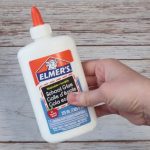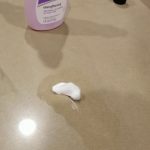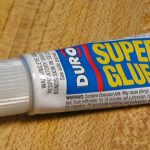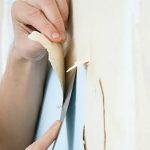This easy-to-use crafting product has gained popularity with crafters and DIYers across the globe.
It comes in dozens of beautiful shades that are compatible with the paint colors available at most major paint retailers. So, what does mod podge work on?
Mod Podge is a glue that works on almost everything. It’s perfect for gluing on fabric, paper, wood, and glass.
It’s especially great for paper mache and decoupage projects. You can even use it on furniture!
So, basically, you can use mod podge on anything.
What Exactly Is Mod Podge?
Contents
In the 1960s, Jan Wetstone invented a product that he called “Mod-Podge.”
The craft was popular in the 1960s, and hippies and other counterculture groups used it all the time to make decorations and gifts for the home.
Wetstone wanted decoupage to be enjoyable and creative, so she created a non-toxic product that did not require the use of harsh chemicals such as shellac or lacquer.
Wetstone, an antique shop owner, had purchased old French decorative plates that had been painted over with gold paint.
Her best-known work was a coffee table covered with seashells that was shown in Life magazine in 1966.
Mod Podge now has several specialty products, like a spray version for fabric, versions with glitter, and even versions that glow in the dark.
Mod Podge now offers specialty finishes, including a matte finish and a textured finish that’s ideal for creating faux tiles or stone surfaces.
What Does Mod Podge Work On?
Mod Podge is a glue-like substance that can be used as a sealant. It’s ideal for sealing photos, papers, fabrics, and more.
You can use it to glue fabric to paper, seal photos and make them water resistant, or decoupage small items.
Although it is often used for DIY projects, you can use it in a lot of other ways. Here are ten uses for Mod Podge.
- Use it as a sealant for wood projects – You can seal wood with Mod Podge to prevent it from peeling, cracking, and staining. You can also use it to seal wooden trays or boxes for decoration.
- Use it to glue fabric onto paper – Mod Podge can be used to glue fabric onto paper for lighter projects. Some fabrics are too heavy and will tear the paper, so it’s best to use fabrics that are designed to be glued.
- Use it as a sealant for photos – You can use Mod Podge to seal photographs so they won’t fade or stain. You can also seal photographs in wooden frames to protect them against water damage.
- Use it to glue paper onto wood – Mod Podge can be used to glue paper onto wood for decorative purposes. It will dry clear, so it won’t look tacky or cloudy.
- Use it to decoupage small items—You can use Mod Podge to glue small items onto larger items. You can decoupage small decorative objects onto paper, cardboard, or wood.
- Use it to seal envelopes – If you want to seal an envelope, you can use Mod Podge to glue the envelope shut.
- Use it to glue paper onto cardboard – You can use Mod Podge to glue paper onto cardboard to decorate it. Paper won’t tear cardboard, so it’s an easy project to do.
- Use it to glue paper onto glass – You can use Mod Podge to glue paper onto glass for decorative purposes. It is transparent, so you won’t see any residue.
- Use it as a sealant for paper – You can use Mod Podge to seal paper so it won’t tear or stain. It won’t wrinkle the paper or cause it to crack.
- Use it to glue paper onto glass – You can use Mod Podge to glue paper onto glass to decorate it. Paper won’t tear glass, so it’s
Can I Use Mod Podge on Canvas?
Mod Podge will stick to canvas, but you shouldn’t use it on stretched canvas since it can cause the fabric to stretch and loosen.
You can make some gorgeous artwork using photos from your digital collection, and you can decoupage them onto canvases with a bit of craft paint and some matte medium.
Unless you want a white border around your photograph, you should cover the back of the canvas with a layer of regular wallpaper paste before pasting the photo onto the canvas surface.
Apply Mod Podge to the back of the photo and place it on the canvas, smoothing out any air bubbles as you go.
If the parts aren’t fitting properly, lay the photo face down on a flat surface and press down gently with your fingers to make sure it is smooth and even across the surface.
When your design is finished, apply two coats over the top of your design with a brush.
Does Mod Podge Work on Wood?
Mod Podge and varnishes generally don’t mix well together, so you usually shouldn’t use both products on the same project.
It is, in fact, a fun idea to use leftover pieces of fabric from other projects to make a collage on a wooden surface using craft paint and a foam brush.
As with most woodworking tasks, sand the surface lightly before applying the glue and painting to the object you’re decorating.
Then paint the wood surface with the base coat and let it dry completely.
Meanwhile, cut the paper to size, leaving an overhang of about 1/4 inch on each side, and apply a thin coat of decoupage medium to the wood surface using a foam brush.
To remove bubbles, press the paper down with your fingertips and smooth it out with the foam brush if necessary.
Once it’s in place, seal it with another thin coat of decoupage medium and let that dry completely before adding a second coat.
Can I Use Mod Podge on Plastic?
Mod Podge will adhere to many—but certainly not all—plastics.
Hard plastics, for example, include extra layers of plastic that have been bonded together to create a surface that’s hard and inflexible.
When exposed to water and moisture, soft plastics will dissolve.
Can I Use Mod Podge on Clay?
Mod Podge is an excellent sealer for clay objects of all kinds—ceramic sculptures, plates, tiles, and more.
When exposed to air and moisture, polymer clay hardens into a finish that looks like plastic. To make it last longer, you must seal it with a top coat of sealer.
However, you should seal everything that goes in a dishwasher first — even pottery — so keep that in mind if you’re thinking of sealing your ceramic pieces.
After curing and painting, students’ hands, made to look like leopard spots, were covered with a thin layer of mod podge before being sealed with a top coat of polyurethane spray.
Does Mod Podge Work on Fabric?
If you have Fabric Mod Podge on hand, you can use it to coat almost any fabric to give it a smooth, glossy finish — even cotton.
It may be used to seal the edges of a pillow or quilt to keep them from fraying before sewing them up, but you shouldn’t use it to sew the fabric together or glue the fabric to anything else.
Working with fabric may cause fraying around the edges of the fabric, and there’s no way to guarantee that the finished piece will remain smooth and intact after washing it several times.
Does Mod Podge Work on Glass?
Glass can be used successfully as a substrate for artwork using a variety of mediums, including spray paints, dyes, and acrylic paints.
Use doilies, stickers, ribbons, fabric, paper, and other decorative items to create a one-of-a-kind work of art that can be hung on the wall or set on a shelf to show off its gorgeous colors.
Conclusion
Mod Podge is a multi-purpose solution that can be used to adhere paper to wood, glass, ceramics, and a variety of other surfaces in a wide variety of ways.
It works on practically any surface, but be advised that it may damage some materials when used improperly.






